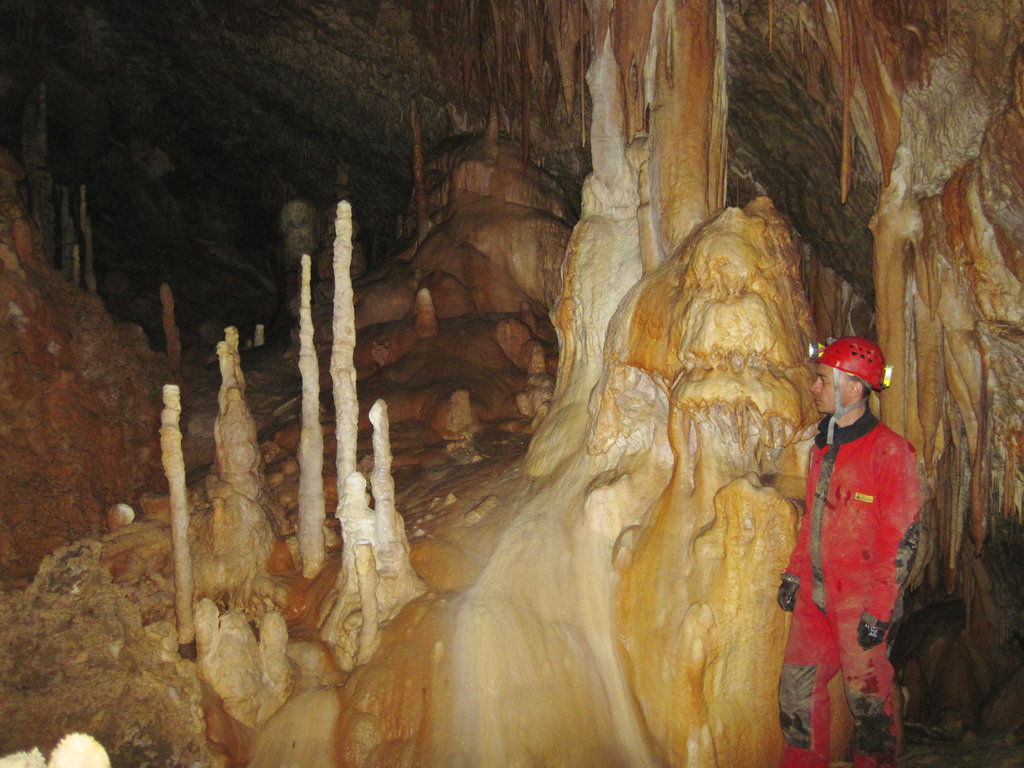Cold, dry climate shifts linked to Neanderthal disappearance

In this 2013 photo provided by Bogdan Onac, researcher Vasile Ersek stands in the Ascunsa Cave in Romania. Scientists say ancient shifts in climate helped our species replace Neanderthals in Europe. Researchers used data from this cave and another to document two lengthy cold and dry periods. The report, released Monday, Aug. 27, 2018, by the Proceedings of the National Academy of Sciences, found these periods coincided with the disappearance of Neanderthals and the arrival of our species in specific places. (Bogdan Onac via AP)
NEW YORK — Ancient periods of cold and dry climate helped our species replace Neanderthals in Europe, a study suggests.
Researchers found that such cold periods coincided with an apparent disappearance of our evolutionary cousins in different parts of the continent, followed by the appearance of our species, Homo sapiens.
“Whether they moved or died out, we can’t tell,” said Michael Staubwasser of the University of Cologne in Germany.
Neanderthals once lived in Europe and Asia but died out about 40,000 years ago, just a few thousand years after our species, Homo sapiens, arrived in Europe. Scientists have long debated what happened, and some have blamed the change in climate. Other proposed explanations have included epidemics and the idea that the newcomers edged out the Neanderthals for resources.
Staubwasser and colleagues reported their findings Monday in the Proceedings of the National Academy of Sciences. They drew on existing climate, archaeological and ecological data and added new indicators of ancient climate from studies of two caves in Romania.
Their study highlighted two cold and dry periods. One began about 44,000 years ago and lasted about 1,000 years. The other began about 40,800 years ago and lasted six centuries. The timing of those events matches the periods when artifacts from Neanderthals disappear and signs of Homo sapiens appear in sites within the Danube River valley and in France, they noted.
The climate shifts would have replaced forest with shrub-filled grassland, and Homo sapiens may have been better adapted to that new environment than the Neanderthals were, so they could move in after Neanderthals disappeared, the researchers wrote.
Katerina Harvati, a Neanderthal expert at the University of Tuebingen in Germany who wasn’t involved in the study, said it’s helpful to have the new climate data from southeastern Europe, a region that H. sapiens is thought to have used to spread through the continent.
But she said it’s unclear whether Neanderthals disappeared and H. sapiens appeared at the times the authors indicate, because the studies they cite rely on limited evidence and are sometimes open to dispute.
Chris Stringer of the Natural History Museum in London said he thought the paper made a good case for an impact of the climate shifts on Neanderthals, although he believes other factors were also at work in their disappearance.
Rick Potts of the Smithsonian Institution called the study “a refreshing new look” at the species replacement.
“As has been said before, our species didn’t outsmart the Neanderthals,” Potts said in an email. “We simply outsurvived them. The new paper offers much to contemplate about how it occurred.” /muf